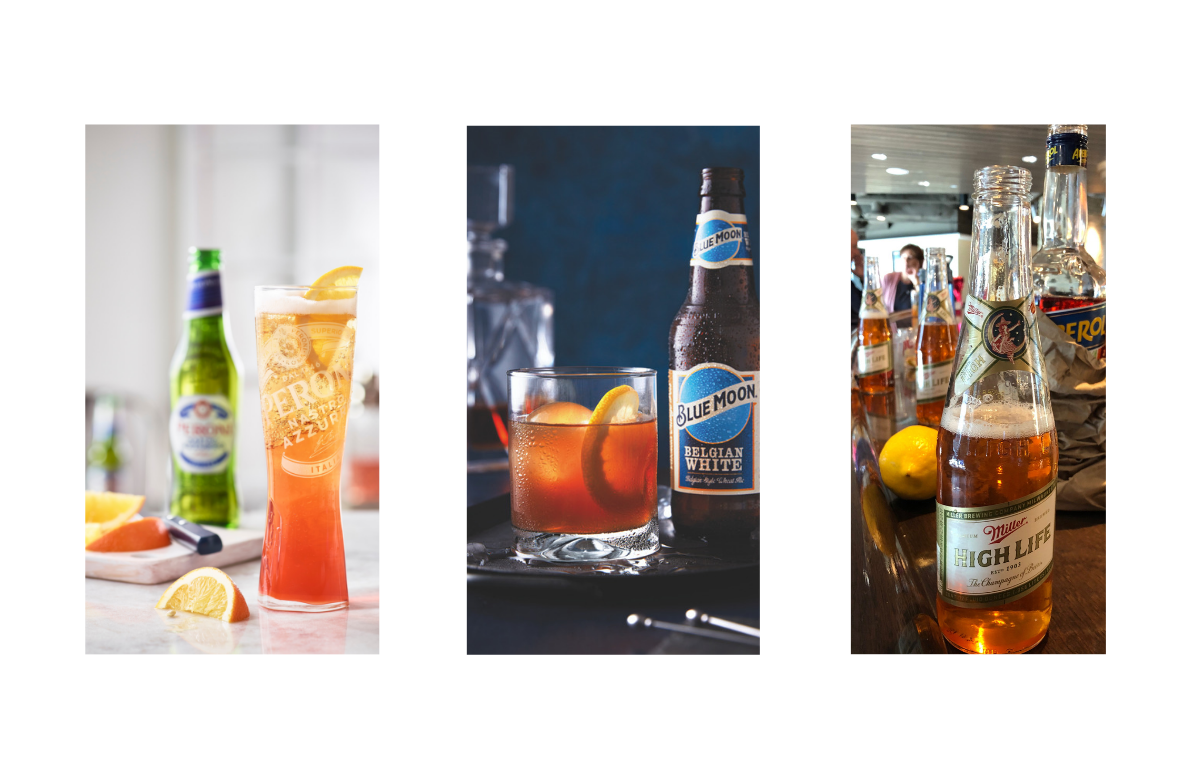Beer wants a bigger presence at drinking occasions where cocktails have become the drink of choice. Part of its solution? Become part of the cocktails.
Brands such as Blue Moon and Peroni over the past two years have unveiled recipes for branded beertails, a type of cocktail in which the base ingredient is beer. Meanwhile, bartenders working on their own developed the spaghett, a cocktail created by pouring a shot of Aperol and a spritz of lemon into a bottle of Miller High Life, which became a summer phenomenon.
“What it all comes down to is that beer is missing out on a lot of opportunities,” says Jason Pratt, senior marketing manager of innovations for MillerCoors. With beer-based cocktails, “we’re giving drinkers who may not be in the mood to drink a beer a reason to nonetheless have in their glass and a chance to explore new flavors. We’re extending more occasions to include beer, and that’s a win.”
While beer-based bloody marys and micheladas have been around for years, the idea of blending beer with spirits and other ingredients to create cocktails is a relatively recent phenomenon. Blue Moon was among the first brands to jump on the trend, releasing four beer-based cocktails last year, then two more this spring to coincide with the Kentucky Derby.
America’s top-selling craft beer released recipes for cocktails using each of the four most popular spirits — vodka, tequila, whiskey and rum. Each was modeled after familiar spirit-based cocktails that worked well with Blue Moon’s bright, citrus element and hint of subtle spice and contain more than 50% beer. This year’s Derby-inspired drinks contain bourbon and Aperol.
“The fun part about mixology is that our initial objective was to unlock more late-night occasions for Blue Moon, primarily in the on-premise, when drinkers typically transitioned to spirits,” says Elizabeth Hitch, senior marketing manager for Blue Moon. “But we found that mixology can work for Blue Moon in other occasions, such as entertaining and at parties at drinkers’ homes. It has allowed Blue Moon to remain relevant in a multitude of occasions and places throughout the year.”
The program has proved successful, increasing consideration for Blue Moon among younger legal-age drinkers who also drink spirits, Hitch says. Blue Moon plans at least six more cocktails for 2020.
Peroni, meanwhile, had a slightly different motivation for releasing three Peroni-based cocktails this summer. The brand, which got its first national advertising support this year, is growing like mad, fueled by increased distribution and a bigger marketing budget.
Peroni’s cocktails, each of which use Italian spirits and ingredients, “are refreshing and connected to a real place — our homeland of Italy. They transport you to a mindset where you can imagine you’re drinking on the Italian coastline, which is what you get with Peroni,” says Katie Feldman, marketing manager for prestige imports at Tenth and Blake, the MillerCoors craft and import arm.
Since Peroni already sources more than 75% of its volume from spirits, it has “every right to play in the cocktail space,” Feldman says.
“There’s a huge interaction between Peroni drinkers and spirits, the result being Peroni is seen as a beer for special, higher-end occasions,” she says. “It’s an elevated beer for special occasions where you’d typically see a lot of high-end cocktails and wine. And as this brand continues to gain traction in the market and people seek new ways to experience it, crafting cocktails from Peroni offers a new twist on an already wonderful option.”
Then there’s the story of Miller High Life, which became a bit of a viral sensation this summer after the food magazine Bon Appetit posted an ode to the spaghett, which was starting to make its way around New York City.
Simple to execute, fun to drink and aided by the theater of the red hue the Aperol imbues in the clear bottle of Miller High Life, the beertail became a surprise hit of late summer.
The fact that the drink originated from outside the company “gave it some authenticity” and momentum it may not have garnered otherwise, Pratt says. “We’re pretty honored when the people out there selling our brands over the bar day-to-day choose to incorporate them in a new way. High Life was a cool choice, for sure.”
As to whether the trend of using beer in cocktails will continue? Pratt says the answer is an unequivocal yes. “Anything that helps connect with consumers and make things more interesting for them is worth trying.”

